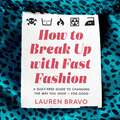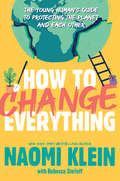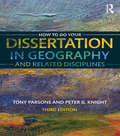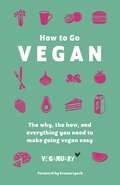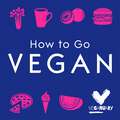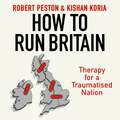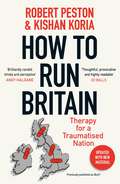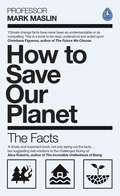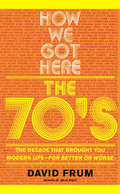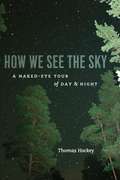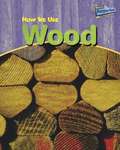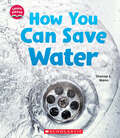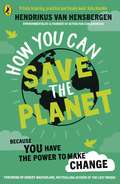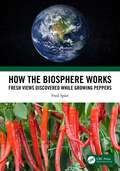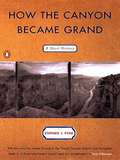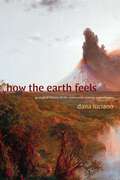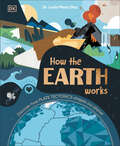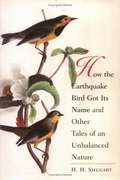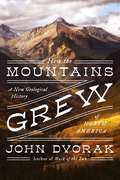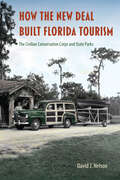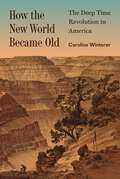- Table View
- List View
How To Break Up With Fast Fashion: A guilt-free guide to changing the way you shop – for good
by Lauren BravoYou probably know the statistics: global clothing production has roughly doubled in just 15 years, and every year an estimated 300,000 tonnes of used clothing ends up in UK landfill. Fast fashion is the ultimate toxic relationship. It's bad news for the planet, our brains and our bank balances. We can't go on like this; our shopping habits need an overhaul.Journalist Lauren Bravo loves clothes more than anything, but she's called time on her affair with fast fashion in search of a slower, saner way of dressing. In this book, she'll help you do the same. How To Break Up With Fast Fashion will help you to change your mindset, fall back in love with your wardrobe and embrace more sustainable ways of shopping - from the clothes swap to the charity shop. Full of refreshing honesty and realistic advice, Lauren will inspire you to repair, recycle and give your unloved items a new lease of life without sacrificing your style. Because fashion belongs to everyone, but no outfit should cost us the earth. (P)2020 Headline Publishing Group Ltd
How To Change Everything: The Young Human's Guide to Protecting the Planet and Each Other
by Naomi Klein Rebecca StefoffA long-awaited guide to climate action and justice for young readers by bestselling, award-winning, internationally acclaimed writer and climate activist Naomi Klein.Temperatures are rising all over the world, leading to wildfires, droughts, animal extinctions and ferocious storms -- climate change is real. But how did we get to this state, and what can we do next? What if we could work to protect the planet, while also taking action to make life fairer and more equal for the people who live on it? We can -- if we're willing to change everything. In her first book written for young readers, internationally acclaimed, bestselling author and social activist Naomi Klein, with Rebecca Steffof, lays out the facts and challenges of climate change and the movement for climate justice. Using examples of change and protest from around the world, including profiles of young activists from a wide range of backgrounds, Klein shows that young people are not just part of the climate change movement, they are leading the way. How to Change Everything will provide readers with clear information about how our planet is changing, but also, more importantly, with inspiration, ideas, and tools for action. Because young people can help build a better future. Young people can help decide what happens next. Young people can help change everything.
How To Do Your Dissertation in Geography and Related Disciplines
by Tony Parsons Peter G KnightThis book provides undergraduates with a step-by-step guide to successfully carrying out an independent research project or dissertation. The book addresses each stage of the project by answering the questions that a student is likely to ask as the work progresses from choosing the subject area and planning the data collection through to producing illustrations and writing the final report. Most undergraduates in geography and related disciplines are required to undertake individual projects as part of their degree course; this book is a source of constructive, practical advice. This new third edition continues the tradition of friendly, well-informed but informal support, and continues to focus on answering the specific questions that students typically ask at each stage of the project. The new edition brings the text completely up to date by taking into account changes within the discipline and changes in the ways that students work. New digital media, social networking, mobile technology, e-journals, anti-plagiarism software, ethics approval rules and risk assessments are among the issues that this new edition takes into account. The new edition also broadens the book’s appeal by extending its coverage of the wide range of different approaches to geographical research, with expanded coverage of qualitative research, Geographic Information Systems, and new approaches to research design in both physical and human geographies
How To Go Vegan: The why, the how, and everything you need to make going vegan easy
by VeganuaryGoing vegan is easy!Whether you're already a full-time vegan, considering making the switch or know someone who is, this book will give you all the tools you need to make the change towards a healthier, happier and more ethical lifestyle. How to Go Vegan includes...Why try vegan?Animal welfare, the environment, health benefits and your personal adventure.Vegan at homeSurprisingly vegan foods, reading labels, vegan ingredient essentials, easy replacements, how to be the only vegan in the familyVegan out in the worldEating out, eating at friends' houses, answering questions from loved ones, travelling veganLiving the vegan lifestyleMeal plans, tips and tricks, what to do if you're struggling, how to celebrate being a veganHow to go vegan. It's easier than you think.
How To Go Vegan: The why, the how, and everything you need to make going vegan easy
by VeganuaryEver thought about eating less meat and fewer dairy products? Concerned about animal welfare and the environment? Interested in the health benefits of a plant-based lifestyle? This is the book for you. In this fun, easy to follow and informative guide, the team behind the charity Veganuary provide everything you need to make changes towards leading a healthier, more ethical and sustainable lifestyle. From your motivations, tips for eating out, easy substitutions and making sure you get the right nutrients, this book is a lifesaver for vegans, those wanting to give veganism a try, or for friends and family. Try going vegan for one month - with How To Be Vegan it is easier than you think.
How To Go Vegan: The why, the how, and everything you need to make going vegan easy
by Veganuary Trading LimitedA short guide to going vegan - the why, the what and the how.Ever thought about eating less meat and fewer dairy products? Concerned about animal welfare and the environment? Interested in the health benefits of a plant-based lifestyle? This is the book for you. In this fun, easy to follow and informative guide, the team behind the charity Veganuary provide everything you need to make changes towards leading a healthier, more ethical and sustainable lifestyle. From your motivations, tips for eating out, easy substitutions and making sure you get the right nutrients, this book is a lifesaver for vegans, those wanting to give veganism a try, or for friends and family. Try going vegan for one month - with How To Be Vegan it is easier than you think.(P)2017 Hodder & Stoughton
How To Run Britain: Therapy For A Traumatised Nation
by Robert PestonTHE MUST-READ BOOK FROM ITV'S ROBERT PESTON AND KISHAN KORIA, REVISED AND UPDATED FOLLOWING THE GENERAL ELECTION *Previously published as Bust?*---------Britain is facing uncertainty, threats and risk: new Prime Minister, new government, new political landscape, at home and abroad. But how much should change? And how much will change?How To Run Britain is a plea from Robert Peston and Kishan Koria to own what's gone wrong and make courageous reforms to everything, from the way we manage the economy to how we vote. We all know that, over the past fifteen years, British living standards have stagnated, inequality between - and within - communities has grown rampant, politicians have lost credibility and the trust of the nation. Millions say they are unheard and disenfranchised, victimised even. A far-right racist minority feels entitled to riot. But what do those problems really mean - and how do we fix them? How can politicians win the trust back from voters, from teachers, doctors, students, pensioners - all those who feel left behind by those who purport to act in their best interest?Peston and Koria's argument is simple: first, we must interrogate everything that has gone wrong, and build solutions from there. This is not the time to shy away from the recent past, nor should we indulge in it. Instead, we should take the lessons learned over the past fifteen years and build a future-focused, strategic plan for restoring economic, political and social security to the country we know and love.How To Run Britain is a manifesto for change in its simplest, clearest form, from the minds of two people who have seen it all.This is an updated, retitled edition of Bust? by Robert Peston and Kishan Koria, published in 2023.
How To Run Britain: Therapy For A Traumatised Nation
by Robert PestonTHE MUST-READ BOOK FROM ITV'S ROBERT PESTON AND KISHAN KORIA, REVISED AND UPDATED FOLLOWING THE GENERAL ELECTION *Previously published as Bust?*---------Britain is facing uncertainty, threats and risk: new Prime Minister, new government, new political landscape, at home and abroad. But how much should change? And how much will change?How To Run Britain is a plea from Robert Peston and Kishan Koria to own what's gone wrong and make courageous reforms to everything, from the way we manage the economy to how we vote. We all know that, over the past fifteen years, British living standards have stagnated, inequality between - and within - communities has grown rampant, politicians have lost credibility and the trust of the nation. Millions say they are unheard and disenfranchised, victimised even. A far-right racist minority feels entitled to riot. But what do those problems really mean - and how do we fix them? How can politicians win the trust back from voters, from teachers, doctors, students, pensioners - all those who feel left behind by those who purport to act in their best interest?Peston and Koria's argument is simple: first, we must interrogate everything that has gone wrong, and build solutions from there. This is not the time to shy away from the recent past, nor should we indulge in it. Instead, we should take the lessons learned over the past fifteen years and build a future-focused, strategic plan for restoring economic, political and social security to the country we know and love.How To Run Britain is a manifesto for change in its simplest, clearest form, from the minds of two people who have seen it all.This is an updated, retitled edition of Bust? by Robert Peston and Kishan Koria, published in 2023.
How To Run Britain: Therapy For A Traumatised Nation
by Robert PestonTHE MUST-READ BOOK FROM ITV'S ROBERT PESTON AND KISHAN KORIA, REVISED AND UPDATED FOLLOWING THE GENERAL ELECTION *Previously published as Bust?*---------Britain is facing uncertainty, threats and risk: new Prime Minister, new government, new political landscape, at home and abroad. But how much should change? And how much will change?How To Run Britain is a plea from Robert Peston and Kishan Koria to own what's gone wrong and make courageous reforms to everything, from the way we manage the economy to how we vote. We all know that, over the past fifteen years, British living standards have stagnated, inequality between - and within - communities has grown rampant, politicians have lost credibility and the trust of the nation. Millions say they are unheard and disenfranchised, victimised even. A far-right racist minority feels entitled to riot. But what do those problems really mean - and how do we fix them? How can politicians win the trust back from voters, from teachers, doctors, students, pensioners - all those who feel left behind by those who purport to act in their best interest?Peston and Koria's argument is simple: first, we must interrogate everything that has gone wrong, and build solutions from there. This is not the time to shy away from the recent past, nor should we indulge in it. Instead, we should take the lessons learned over the past fifteen years and build a future-focused, strategic plan for restoring economic, political and social security to the country we know and love.How To Run Britain is a manifesto for change in its simplest, clearest form, from the minds of two people who have seen it all.This is an updated, retitled edition of Bust? by Robert Peston and Kishan Koria, published in 2023.
How To Save Our Planet: The Facts
by Mark A. Maslin'Punchy and to the point. No beating around the bush. This brilliant book contains all the information we need to have in our back pocket in order to move forward' Christiana Figueres, Former Executive Secretary UN Climate Change Convention'Amazing book' Chris Evans, Virgin Radio Breakfast Show'Everyone should have this book' Rick Edwards, BBC Radio 5 Live'A timely and important book, not only laying out the facts...but suggesting real solutions to the challenges facing us' Professor Alice Roberts, Anatomist, Professor of Public Engagement in Science, University of Birmingham_________________________ How can we save our planet and survive the 21st century? How can you argue with deniers? How can we create positive change in the midst of the climate crisis? Professor Mark Maslin has the key facts that we need to protect our future. Global awareness of climate change is growing rapidly. Science has proven that our planet and species are facing a massive environmental crisis. How to Save Our Planet is a call to action, guaranteed to equip everyone with the knowledge needed to make change. Be under no illusion the challenges of the twenty-first century are immense. We need to deal with: climate change, environmental destruction, global poverty and ensure everyone's security. We have the technology. We have the resources. We have the money. We have the scientists, the entrepreneurs and the innovators. We lack the politics and policies to make your vision of a better world happen. So we need a plan to save our planet... How to Save Our Planet is your handbook of how we together can save our precious planet. From the history of our planet and species, to the potential of individuals and our power to create a better future, Maslin inspires optimism in these bleak times. We stand at the precipice. The future of our planet is in our hands. It's time to face the facts and save our planet from, and for, ourselves._________________________'A handbook of clearly established, authoritative facts and figures about the terrible toll we as humans have taken of our planet, plus ways in which we can lessen the impact. For laypeople like me, who can see what is happening but haven't always got the precise statistics to hand, it's hugely valuable' John Simpson CBE, BBC World Affairs Editor, Broadcaster, Author & Columnist'Saving the world is no small thing, but picking up this book's a good start' Paris Lees, Contributing Editor at British Vogue, campaigner'I love it. My kids love it' Chris Evans, Virgin Radio Breakfast Show'A no-nonsense crib sheet on the state of the world and how to help it' The I Newspaper
How We Got Here: The 70s The Decade That Brought You Modern Life -- For Better Or Worse
by David FrumFor many, the 1970s evoke the Brady Bunch and the birth of disco. In this first, thematic popular history of the decade, David Frum argues that it was the 1970s, not the 1960s, that created modern America and altered the American personality forever. A society that had valued faith, self-reliance, self-sacrifice, and family loyalty evolved in little more than a decade into one characterized by superstition, self-interest, narcissism, and guilt. Frum examines this metamorphosis through the rise to cultural dominance of faddish psychology, astrology, drugs, religious cults, and consumer debt, and profiles such prominent players of the decade as Werner Erhard, Alex Comfort, and Jerry Brown. How We Got Here is lively and provocative reading.
How We Know What We Know about Our Changing Climate: Scientists and Kids Explore Global Warming
by Lynne CherryWhen the weather changes daily, how do we really know that Earth's climate is changing? Here is the science behind the headlines - evidence from flowers, butterflies, birds, frogs, trees, glaciers and much more, gathered by scientists from all over the world, sometimes with assistance from young "citizen-scientists." And here is what young people, and their families and teachers, can do to learn about climate change and take action. Climate change is a critical and timely topic of deep concern, here told in an age-appropriate manner, with clarity and hope. Kids can make a difference!
How We See the Sky: A Naked-Eye Tour of Day & Night
by Thomas HockeyGazing up at the heavens from our backyards or a nearby field, most of us see an undifferentiated mess of stars—if, that is, we can see anything at all through the glow of light pollution. Today’s casual observer knows far less about the sky than did our ancestors, who depended on the sun and the moon to tell them the time and on the stars to guide them through the seas. Nowadays, we don’t need the sky, which is good, because we’ve made it far less accessible, hiding it behind the skyscrapers and the excessive artificial light of our cities. How We See the Sky gives us back our knowledge of the sky, offering a fascinating overview of what can be seen there without the aid of a telescope. Thomas Hockey begins by scanning the horizon, explaining how the visible universe rotates through this horizon as night turns to day and season to season. Subsequent chapters explore the sun’s and moon’s respective motions through the celestial globe, as well as the appearance of solstices, eclipses, and planets, and how these are accounted for in different kinds of calendars. In every chapter, Hockey introduces the common vocabulary of today’s astronomers, uses examples past and present to explain them, and provides conceptual tools to help newcomers understand the topics he discusses. Packed with illustrations and enlivened by historical anecdotes and literary references, How We See the Sky reacquaints us with the wonders to be found in our own backyards.
How We Use Wood
by Chris OxladeHow We Use Wood will give you answers to these and many other questions: Why is wood a good material for building boats? How do we get paper from wood? Why we use wood to make drain pipes?
How You Can Save Water (Learn About)
by Dionna L. MannAn essential tool to teach kids about the importance of water!Did you know that when water appears in your home, it must disappear from somewhere else? And that freshwater supply has to be shared by 7.7 billion people on Earth? If people do not conserve freshwater, there will not be enough for everyone. The good news is that there are lots of ways you can help save water. Learn all about them in How You Can Save Water.ABOUT THIS SERIES: Earth is known as the Blue Planet because of the abundant amount of water that covers our home. And nothing on Earth could survive without it. As we find ourselves facing a global water crisis, learning about this life-giving resource has never been more important. The books in this series are filled with colorful photos and diagrams, plus easy-to-digest text, and fascinating facts. And they offer young readers an in-depth look at what water is, how we use it, and most importantly, what we can do to protect it.
How You Can Save the Planet
by Hendrikus van Hensbergen*Foreword by Robert Macfarlane, bestselling author of The Lost Words.*If you're worried about climate change, this book is an essential and reassuring read.We often feel like we don't have the power to make real change.But our small changes can add up to something BIG. Packed with reassuring step by step actions and easy to follow DIY activities, How You Can Save The Planet is the perfect gift for young activists who want to make a difference.With simple explanations, practical tips and stories from children across the world, this guide is ideal for young people who are worried about climate change and want to help our planet!Crafted by Hendrikus van Hensbergen, whose work is featured on BBC Bitesize[JP2] , this inspiring read is perfect for children at KS2. 'Every young person in the country should be given this book' Sir Tim Smit, Founder of The Eden Project'It's enlightening, inspiring and empowering' Kate Humble, TV presenter'Wonderfully informative, fun and practical [. . .] A great source of inspiration' The Rich Brothers, TV presenters
How a City Works (Let's-Read-and-Find-Out Science 2)
by D. J. WardRead and find out about how cities work in this colorfully illustrated nonfiction picture book.Millions of people live in cities around the world, but have you ever wondered how cities work? All those people need clean water to drink, a safe place to live, and a way to get all around the city. How do you take care of all those people’s needs? Read and find out all about the systems a city has to help keep everyone safe, healthy, and happy.This book on city systems will appeal to the young civil engineer. How a City Works is filled with fun, accurate art, and includes tons of information. For example, it answers the question: Where does all the electricity needed to make a city run come from? How a City Works covers water treatment, power, sewage, recycling, and transportation.How a City Works comes packed with visual aids like charts, sidebars, an infographic, and a funny, hands-on activity—how to clean up dirty “sewage” water, using puffed rice cereal, raisins, hot chocolate mix, and coffee filters.This is a clear and appealing science book for early elementary age kids, both at home and in the classroom. It's a Level 2 Let's-Read-and-Find-Out, which means the book explores more challenging concepts for children in the primary grades. The 100+ titles in this leading nonfiction series are:hands-on and visualacclaimed and trustedgreat for classroomsTop 10 reasons to love LRFOs:Entertain and educate at the same timeHave appealing, child-centered topicsDevelopmentally appropriate for emerging readersFocused; answering questions instead of using survey approachEmploy engaging picture book quality illustrationsUse simple charts and graphics to improve visual literacy skillsFeature hands-on activities to engage young scientistsMeet national science education standardsWritten/illustrated by award-winning authors/illustrators & vetted by an expert in the fieldOver 130 titles in print, meeting a wide range of kids' scientific interestsBooks in this series support the Common Core Learning Standards, Next Generation Science Standards, and the Science, Technology, Engineering, and Math (STEM) standards. Let's-Read-and-Find-Out is the winner of the American Association for the Advancement of Science/Subaru Science Books & Films Prize for Outstanding Science Series.
How the Biosphere Works: Fresh Views Discovered While Growing Peppers
by Fred SpierHow the Biosphere Works: Fresh Views Discovered While Growing Peppers offers a simple and novel theoretical approach to understanding the history of the biosphere, including humanity’s place within it. It also helps to clarify what the possibilities and limitations are for future action. This is a subject of wide interest because today we are facing a great many environmental issues, many of which may appear unconnected. Yet all these issues are part of our biosphere. For making plans for the future and addressing our long-term survival and well-being, an integrated knowledge of our biosphere and its history is therefore indispensable. Key Features Documents what the biosphere is, and what our position as humans within it is today. Describes how the biosphere has become the way it is. Summarizes the novel simple theoretical model proposed in the book, and thus, how the biosphere functions. Predicts what the possibilities and limitations are for future human action Emphasizes how simple but careful observations can lead to far-reaching theoretical implications.
How the Canyon Became Grand
by Pyne Stephen J.Dismissed by the first Spanish explorers as a wasteland, the Grand Canyon lay virtually unnoticed for three centuries until nineteenth- century America rediscovered it and seized it as a national emblem. This extraordinary work of intellectual and environmental history tells two tales of the Canyon: the discovery and exploration of the physical Canyon and the invention and evolution of the cultural Canyon--how we learned to endow it with mythic significance. Acclaimed historian Stephen Pyne examines the major shifts in Western attitudes toward nature, and recounts the achievements of explorers, geologists, artists, and writers, from John Wesley Powell to Wallace Stegner, and how they transformed the Canyon into a fixture of national identity. This groundbreaking book takes us on a completely original journey through the Canyon toward a new understanding of its niche in the American psyche, a journey that mirrors the making of the nation itself. .
How the Earth Feels: Geological Fantasy in the Nineteenth-Century United States (ANIMA: Critical Race Studies Otherwise)
by Dana LucianoIn How the Earth Feels Dana Luciano examines the impacts of the new science of geology on nineteenth-century US culture. Drawing on early geological writings, Indigenous and settler accounts of earthquakes, African American antislavery literature, and other works, Luciano reveals how geology catalyzed transformative conversations regarding the intersections between humans and the nonhuman world. She shows that understanding the earth’s history geologically involved confronting the dynamic nature of inorganic matter over vast spans of time, challenging preconceived notions of human agency. Nineteenth-century Americans came to terms with these changes through a fusion of fact and imagination that Luciano calls geological fantasy. Geological fantasy transformed the science into a sensory experience, sponsoring affective and even erotic connections to the matter of the earth. At the same time, it was often used to justify accounts of evolution that posited a modern, civilized, and Anglo-American whiteness as the pinnacle of human development. By tracing geology’s relationship with biopower, Luciano illuminates how imagined connections with the earth shaped American dynamics of power, race, and colonization.
How the Earth Works: Discover How Plate Tectonics Shapes Our Planet
by Dr. Lucia Perez-DiazSee below the surface of Earth and discover the secrets that lie beneath our feet in this fascinating book about Earth.Author Dr. Lucía Pérez-Díaz offers budding young Earth scientists aged 7-9 everything they need to decode the puzzle that is planet Earth.On a journey like no other, children will learn what our planet was once like, how and why it has changed, and what the future may hold. They will adventure through earthquakes and over towering mountains to learn about our landscapes and unlock clues to Earth’s long history.This Earth science book for children offers: A unique adventure through Earth for kids, covering the past, present and future of our planet’s geography.An in-depth look at the trending topics of Earth and the environment in relation to rising global temperatures.Information on topics like plate tectonics, and how human actions and the climate affect this.How the Earth Works digs into all that happens beneath our feet in an accessible and lively manner. The pages of this book are charged with Dr. Lucía Pérez-Díaz’s passion and expertise, as she helps us to explore the inner workings of our planet. Filled with dynamic illustrations, this geology book takes on plate tectonics in a digestible and adventurous way that you don’t want to miss!
How the Earthquake Bird Got Its Name: And Other Tales of an Unbalanced Nature
by H. H. ShugartAlthough people have been altering earth's landscapes to some extent for tens of thousands of years, humankind today is causing massive changes to the planet. Such widespread environmental change is accompanied by accelerating rates of species extinction. In this book, noted ecologist H. H. Shugart presents important ecological concepts through entertaining animal parables. He tells the stories of particular birds and mammals--the packrat, ivory-billed woodpecker, penguin, dingo, European rabbit, and others--and what their fates reveal about the interactions between environmental change and the extinctions or explosions of species populations. Change is the root of many planetary problems, but it is also an intrinsic feature of our living planet. Shugart explores past environmental change, discusses the non-existence of a "balance of Nature," and documents how human alterations have affected plants, soils, and animals. He looks with hope toward a future in which thoughtful people learn-and use-ecological science to protect the landscapes upon which terrestrial creatures depend.
How the Mountains Grew: A New Geological History of North America
by John DvorakThe incredible story of the creation of a continent—our continent— from the acclaimed author of The Last Volcano and Mask of the Sun.The immense scale of geologic time is difficult to comprehend. Our lives—and the entirety of human history—are mere nanoseconds on this timescale. Yet we hugely influenced by the land we live on. From shales and fossil fuels, from lake beds to soil composition, from elevation to fault lines, what could be more relevant that the history of the ground beneath our feet? For most of modern history, geologists could say little more about why mountains grew than the obvious: there were forces acting inside the Earth that caused mountains to rise. But what were those forces? And why did they act in some places of the planet and not at others? When the theory of plate tectonics was proposed, our concept of how the Earth worked experienced a momentous shift. As the Andes continue to rise, the Atlantic Ocean steadily widens, and Honolulu creeps ever closer to Tokyo, this seemingly imperceptible creep of the Earth is revealed in the landscape all around us. But tectonics cannot—and do not—explain everything about the wonders of the North American landscape. What about the Black Hills? Or the walls of chalk that stand amongst the rolling hills of west Kansas? Or the fact that the states of Washington and Oregon are slowly rotating clockwise, and there a diamond mine in Arizona? It all points to the geologic secrets hidden inside the 2-billion-year-old-continental masses. A whopping ten times older than the rocky floors of the ocean, continents hold the clues to the long history of our planet. With a sprightly narrative that vividly brings this science to life, John Dvorak's How the Mountains Grew will fill readers with a newfound appreciation for the wonders of the land we live on.
How the New Deal Built Florida Tourism: The Civilian Conservation Corps and State Parks
by David J. NelsonFlorida Historical Society Rembert Patrick Award Florida Book Awards, Silver Medal for Florida Nonfiction Countering the conventional narrative that Florida’s tourism industry suffered during the Great Depression, this book shows that the 1930s were, in reality, the starting point for much that characterizes modern Florida’s tourism. David Nelson argues that state and federal government programs designed to reboot the economy during this decade are crucial to understanding the state today. Nelson examines the impact of three connected initiatives—the federal New Deal, its Civilian Conservation Corps program (CCC), and the CCC’s creation of the Florida Park Service. He reveals that the CCC designed state parks to reinforce the popular image of Florida as a tropical, exotic, and safe paradise. The CCC often removed native flora and fauna, introduced exotic species, and created artificial landscapes that were then presented as natural. Nelson discusses how Florida business leaders benefitted from federally funded development and the ways residents and business owners rejected or supported the commercialization and shifting cultural identity of their state. A detailed look at a unique era in which the state government sponsored the tourism industry, helped commodify natural resources, and boosted mythical ideas of the “Real Florida” that endure today, this book makes the case that the creation of the Florida Park Service is the story of modern Florida.
How the New World Became Old: The Deep Time Revolution in America (Princeton Modern Knowledge #1)
by Caroline WintererHow the idea of deep time transformed how Americans see their country and themselvesDuring the nineteenth century, Americans were shocked to learn that the land beneath their feet had once been stalked by terrifying beasts. T. rex and Brontosaurus ruled the continent. North America was home to saber-toothed cats and woolly mammoths, great herds of camels and hippos, and sultry tropical forests now fossilized into massive coal seams. How the New World Became Old tells the extraordinary story of how Americans discovered that the New World was not just old—it was a place rooted in deep time.In this panoramic book, Caroline Winterer traces the history of an idea that today lies at the heart of the nation&’s identity as a place of primordial natural beauty. Europeans called America the New World, and literal readings of the Bible suggested that Earth was only six thousand years old. Winterer takes readers from glacier-capped peaks in Yosemite to Alabama slave plantations and canal works in upstate New York, describing how naturalists, explorers, engineers, and ordinary Americans unearthed a past they never suspected, a history more ancient than anyone ever could have imagined.Drawing on archival evidence ranging from unpublished field notes and letters to early stratigraphic diagrams, How the New World Became Old reveals how the deep time revolution ushered in profound changes in science, literature, art, and religion, and how Americans came to realize that the New World might in fact be the oldest world of all.
